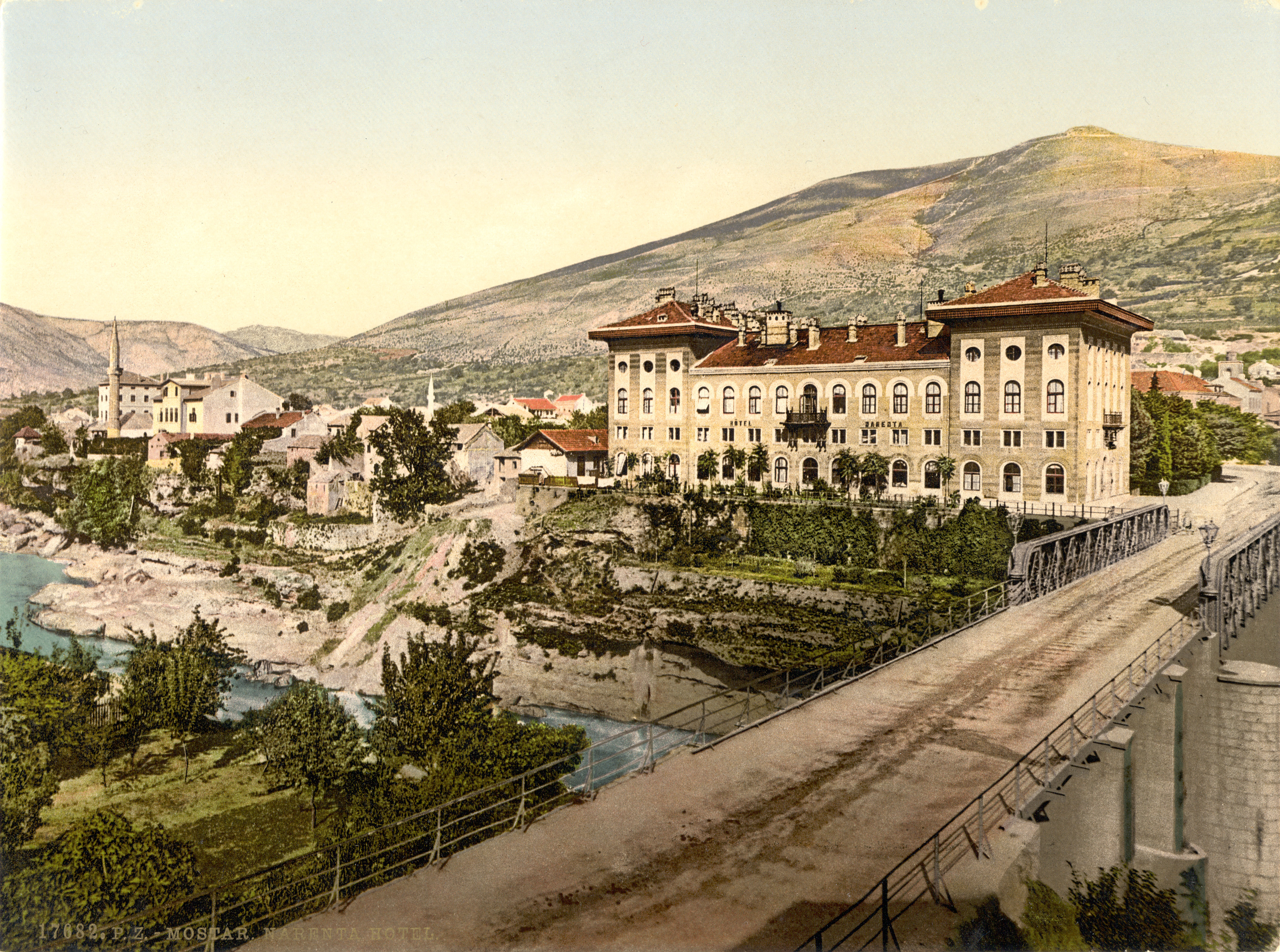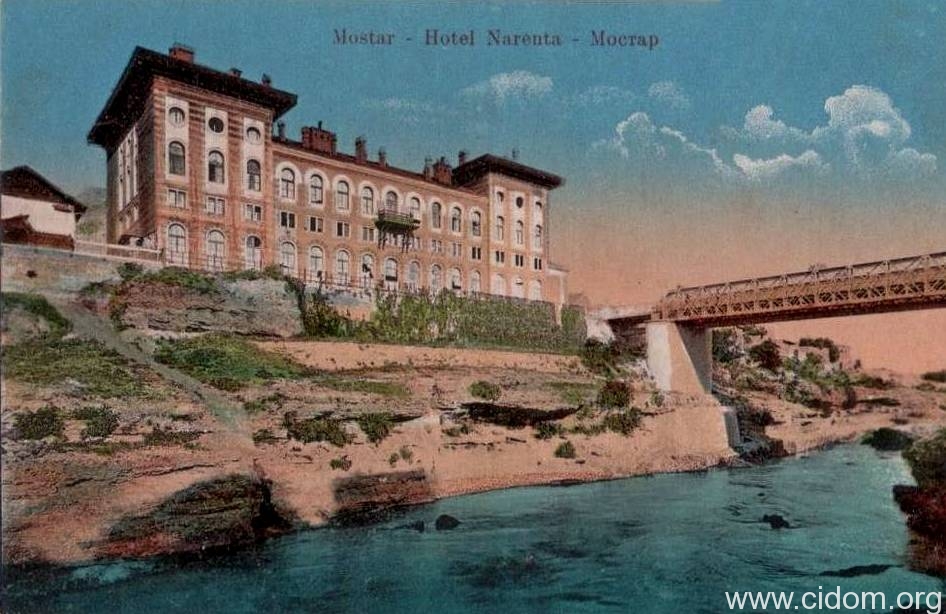Hotel Neretva on:
[Wikipedia]
[Google]
[Amazon]
Hotel Neretva ( sh-Cyrl, Хотел Неретва, links=y) is a hotel in

 In Mostar, at the end of the 19th century, a city zone was defined on the tops of the triangular valley, which is cut along by the Neretva river. The increased traffic needs required a better connection across the Neretva, so in addition to the existing
In Mostar, at the end of the 19th century, a city zone was defined on the tops of the triangular valley, which is cut along by the Neretva river. The increased traffic needs required a better connection across the Neretva, so in addition to the existing
Хотел Неретва у Мостару
- www.youtube.com Hotels in Bosnia and Herzegovina Mostar Buildings and structures in Mostar
Mostar
Mostar (, ; sr-Cyrl, Мостар, ) is a city and the administrative center of Herzegovina-Neretva Canton of the Federation of Bosnia and Herzegovina, an entity of Bosnia and Herzegovina, and the historical capital of Herzegovina.
Mostar is sit ...
, Bosnia and Herzegovina
Bosnia and Herzegovina ( sh, / , ), abbreviated BiH () or B&H, sometimes called Bosnia–Herzegovina and often known informally as Bosnia, is a country at the crossroads of south and southeast Europe, located in the Balkans. Bosnia and H ...
. It was designed in 1890. by architect
An architect is a person who plans, designs and oversees the construction of buildings. To practice architecture means to provide services in connection with the design of buildings and the space within the site surrounding the buildings that h ...
Alexander Wittek
Alexander Wittek (12 October 1852, Sisak – 11 May 1894, Graz) was an Austrian-Hungarian architect and chess master.
As an architect, Wittek worked in Bosnia and Herzegovina during Austro-Hungarian Empire. His most well-known works in Sarajevo a ...
and built in a specific pseudo-Moorish style, which was dominant from the end of the 19th century, on the left bank of the Neretva river
The Neretva ( sr-cyrl, Неретва, ), also known as Narenta, is one of the largest rivers of the eastern part of the Adriatic basin. Four HE power-plants with large dams (higher than 150,5 metres) provide flood protection, power and water s ...
, in the heart of Old town of Mostar, in 1892, during the Austro-Hungarian rule in Bosnia and Herzegovina
Bosnia and Herzegovina fell under Austro-Hungarian rule in 1878, when the Congress of Berlin approved the occupation of the Bosnia Vilayet, which officially remained part of the Ottoman Empire. Three decades later, in 1908, Austria-Hungary pr ...
.
Numerous world leaders have stayed in it to this day, from Emperor Franc Joseph to Josip Broz Tito
Josip Broz ( sh-Cyrl, Јосип Броз, ; 7 May 1892 – 4 May 1980), commonly known as Tito (; sh-Cyrl, Тито, links=no, ), was a Yugoslav communist revolutionary and statesman, serving in various positions from 1943 until his deat ...
and numerous tourists from many parts of the world. On the approximately one hundredth anniversary of the hotel (despite several renovations and additions), the hotel was ripe for a serious renovation, which it did not receive because the hotel building was destroyed in the first months of the Bosnian war
The Bosnian War ( sh, Rat u Bosni i Hercegovini / Рат у Босни и Херцеговини) was an international armed conflict that took place in Bosnia and Herzegovina between 1992 and 1995. The war is commonly seen as having started ...
in 1992, along with almost all important city buildings.Amir Pašić, ''Hotel “Neretva” i “Banja”,'' Мostarskа informativnа revijа MM, brojevi 2 i 3, June, August 1996 godine
The building of the hotel is included into the Provisional List of National Monuments of Bosnia and Herzegovina
The National Monuments of Bosnia and Herzegovina include:
* sites, places, immovable and movable heritage of historical and cultural importance, as designated by the Commission to preserve national monuments of Bosnia and Herzegovina on the basi ...
, by KONS.
History

 In Mostar, at the end of the 19th century, a city zone was defined on the tops of the triangular valley, which is cut along by the Neretva river. The increased traffic needs required a better connection across the Neretva, so in addition to the existing
In Mostar, at the end of the 19th century, a city zone was defined on the tops of the triangular valley, which is cut along by the Neretva river. The increased traffic needs required a better connection across the Neretva, so in addition to the existing Stari Most
Stari Most ( sh-Latn-Cyrl, Stari most, Стари мост, Old Bridge), also known as Mostar Bridge, is a rebuilt 16th-century Ottoman bridge in the city of Mostar in Bosnia and Herzegovina that crosses the river Neretva and connects the two p ...
bridge, which is being adapted for road traffic, three more bridges were built. The central city axis that connected the railway station - the new business center in the west - with the Francis Joseph Bridge (1888) with the mosque on the left bank, was transformed into a new social center. A school, a hotel "Neretva" and a city bath, colloquially named the Banja, are being built on that area, buildings that replace old inns and hammams. Parallel to the construction of this space, the architects of that time introduced eclectic decorative elements collected during study trips of Austrian architects in Egypt and Spain, with the aim of not completely negating the Islamic architectural spirit of the city environment.
Thus, at the end of the 19th century, the "Neretva" hotel was created, which at the time of its construction in 1892 brought to Mostar not only a new architectural style but also the spirit of life in Europe with a new type of guest rooms, meeting rooms or reading rooms accompanied by piano music. The hotel served the famous Sachertorte
Sachertorte (, , ) is a chocolate cake, or torte of Austrian origin, invented by Franz Sacher, supposedly in 1832 for Prince Metternich in Vienna.Michael Krondl, ''Sweet Invention: A History of Dessert'', , 2011, p. 290: "my best guess is ...
cake and Wiener schnitzel, prepared by chefs
A chef is a trained professional cook and tradesman who is proficient in all aspects of food preparation, often focusing on a particular cuisine. The word "chef" is derived from the term ''chef de cuisine'' (), the director or head of a kitche ...
hired from Prague
Prague ( ; cs, Praha ; german: Prag, ; la, Praga) is the capital and largest city in the Czech Republic, and the historical capital of Bohemia. On the Vltava river, Prague is home to about 1.3 million people. The city has a temperate ...
.
The hotel was one of the few places in the city of Mostar where guests could "dance with dinner and variety of cakes, which the waiter brought to the guests' table, so it was difficult for any of the guests to refuse them".
In the hundredth year of its existence, instead of the planned reconstruction, the building was destroyed in the first months of the war on the soil of Bosnia and Herzegovina in 1992, together with almost all important city buildings.
Architectural outlook
With its volume and appearance, the building was foreign to the Herzegovinian with the Ottoman urban history - as a huge building with an imposing facade in monarchical yellow-red horizontal stripes. It was built in pseudo-Moorish style (or as it is more precisely called in science, neo-Islamic or neo-Oriental style) which is characterized by characteristic elements of Hellenistic-Seljuk and Ottoman art taken from the Mozarabic artistic areas of Spain, the Maghreb and Cairo. Many of the buildings left by the Austro-Hungarian government in Bosnia and Herzegovina were built in the pseudo-Moorish style, which remained synonymous with the period of Austro-Hungarian rule in Bosnia and Herzegovina. Formal features most often include horseshoe arches, stucco ornamentation, bulbous domes and decoration of horizontal exterior lines in characteristic colors. The building was built on the very bank of the Neretva River, only many years after its construction, the building made contact with the river through two terraces. The original orientation of the hotel was towards the east, towards a park dominated by a pool with goldfish, which attracted everyone, especially children, until 1976, when the entire area was remodeled by decision of the political structure of the time.Restoration and franchising
After buying the ruined hotel, its new owner Halim Zukić, who needed a full six years to obtain the necessary approvals, did not carry out the work planned in the first phase of the hotel's renovation, which made the building ruinous. When, finally, in 2018, the city officials granted permission for the temporary occupation of public space to Zukić, he opened the construction site for the execution of works and began the restoration, and extension of the "Neretva" hotel. Works are performed under the supervision of the Institute for the Protection of Monuments of the Federation of Bosnia and Herzegovina.Tapestry Collection by Hilton
A company owned by Halim Zukić, ''Interšped d.o.o''. Sarajevo, concluded a franchise agreement withHilton hotel chain
Hilton Hotels & Resorts (formerly known as Hilton Hotels) is a global brand of full-service hotels and resorts and the flagship brand of American multinational hospitality company Hilton.
The original company was founded by Conrad Hilton. As ...
, and announces the opening of two hotels in Bosnia and Herzegovina, one in Sarajevo
Sarajevo ( ; cyrl, Сарајево, ; ''see Names of European cities in different languages (Q–T)#S, names in other languages'') is the Capital city, capital and largest city of Bosnia and Herzegovina, with a population of 275,524 in its a ...
, Sarajevo City Centre Hotel - Hampton by Hilton
Hampton by Hilton, formerly known (and still commonly referred to) as Hampton Inn or Hampton Inn & Suites, is an American chain of hotels trademarked by Hilton Worldwide. The Hampton hotel brand is a chain of moderately priced, budget to midscale ...
, and other in Mostar, Hotel Neretva - Tapestry Collection by Hilton. It is announced that Neretva Hotel will have 80 rooms. The signing of the franchise agreement happened at the Waldorf Astoria Berlin hotel, between Zukić and Executive Vice President of Hilton who is also Hilton's President of the EMEA region.
References
External links
*{{Commons category-inline, Hotel NeretvaХотел Неретва у Мостару
- www.youtube.com Hotels in Bosnia and Herzegovina Mostar Buildings and structures in Mostar
Neretva
The Neretva ( sr-cyrl, Неретва, ), also known as Narenta, is one of the largest rivers of the eastern part of the Adriatic basin. Four HE power-plants with large dams (higher than 150,5 metres) provide flood protection, power and water s ...